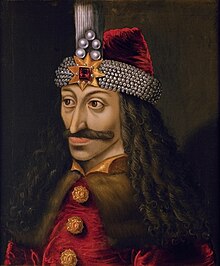
Back Vlad Dracula Afrikaans فلاد الثالث المخوزق Arabic ڤلاد التالت ARZ Vlad Țepeș AST III Vlad Tsepeş Azerbaijani اۆچونجو ولاد AZB Vlad Tsepesch BAR Улад III Цэпеш Byelorussian Улад III Цэпэш BE-X-OLD Влад Цепеш Bulgarian
| Vlad III | |
|---|---|
 Ambras Castle portrait of Vlad III (c. 1560), reputedly a copy of an original made during his lifetime | |
| Voivode of Wallachia | |
| 1st reign | October – November 1448 |
| Predecessor | Vladislav II |
| Successor | Vladislav II |
| 2nd reign | 15 April 1456 – July 1462 |
| Predecessor | Vladislav II |
| Successor | Radu cel Frumos |
| 3rd reign | June 1475 – December 1476 or January 1477 |
| Predecessor | Basarab Laiotă cel Bătrân |
| Successor | Basarab Laiotă cel Bătrân |
| Born | 1428–1431 |
| Died | December 1476 – January 1477 (aged 44–49) |
| Spouse |
|
| Issue | Mihnea |
| House |
|
| Father | Vlad II of Wallachia |
| Mother | Eupraxia of Moldavia (?) |
| Religion |
|
| Signature |  |
Vlad III, commonly known as Vlad the Impaler (Romanian: Vlad Țepeș [ˈvlad ˈtsepeʃ]) or Vlad Dracula (/ˈdrækjʊlə, -jə-/; Romanian: Vlad Drăculea [ˈdrəkule̯a]; 1428/31 – 1476/77), was Voivode of Wallachia three times between 1448 and his death in 1476/77. He is often considered one of the most important rulers in Wallachian history and a national hero of Romania.[4]
He was the second son of Vlad Dracul, who became the ruler of Wallachia in 1436. Vlad and his younger brother, Radu, were held as hostages in the Ottoman Empire in 1442 to secure their father's loyalty. Vlad's eldest brother Mircea and their father were murdered after John Hunyadi, regent-governor of Hungary, invaded Wallachia in 1447. Hunyadi installed Vlad's second cousin, Vladislav II, as the new voivode. Hunyadi launched a military campaign against the Ottomans in the autumn of 1448, and Vladislav accompanied him. Vlad broke into Wallachia with Ottoman support in October, but Vladislav returned, and Vlad sought refuge in the Ottoman Empire before the end of the year. Vlad went to Moldavia in 1449 or 1450 and later to Hungary.
Relations between Hungary and Vladislav later deteriorated, and in 1456 Vlad invaded Wallachia with Hungarian support. Vladislav died fighting against him. Vlad began a purge among the Wallachian boyars to strengthen his position. He came into conflict with the Transylvanian Saxons, who supported his opponents, Dan and Basarab Laiotă (who were Vladislav's brothers), and Vlad's illegitimate half-brother, Vlad Călugărul. Vlad plundered the Saxon villages, taking the captured people to Wallachia, where he had them impaled (which inspired his cognomen). Peace was restored in 1460.
The Ottoman Sultan, Mehmed II, ordered Vlad to pay homage to him personally, but Vlad had the Sultan's two envoys captured and impaled. In February 1462, he attacked Ottoman territory, massacring tens of thousands of Turks and Muslim Bulgarians. Mehmed launched a campaign against Wallachia to replace Vlad with Vlad's younger brother, Radu. Vlad attempted to capture the sultan at Târgoviște during the night of 16–17 June 1462. The Sultan and the main Ottoman army left Wallachia, but more and more Wallachians deserted to Radu. Vlad went to Transylvania to seek assistance from Matthias Corvinus, King of Hungary, in late 1462, but Corvinus had him imprisoned.
Vlad was held in captivity in Visegrád from 1463 to 1475. During this period, anecdotes about his cruelty started to spread in Germany and Italy. He was released at the request of Stephen III of Moldavia in the summer of 1475. He fought in Corvinus's army against the Ottomans in Bosnia in early 1476. Hungarian and Moldavian troops helped him to force Basarab Laiotă (who had dethroned Vlad's brother, Radu) to flee from Wallachia in November. Basarab returned with Ottoman support before the end of the year. Vlad was killed in battle before 10 January 1477.
Books describing Vlad's cruel acts were among the first bestsellers in the German-speaking territories. In Russia, popular stories suggested that Vlad was able to strengthen his central government only by applying brutal punishments, and many 19th-century Romanian historians adopted a similar view. Vlad's patronymic inspired the name of Bram Stoker's literary vampire, Count Dracula.
- ^ Cazacu 2017, pp. 81–83.
- ^ Treptow 2000, p. 161.
- ^ Balotă 1991, p. 207.
- ^ "Vlad the Impaler | Biography, Dracula, & Facts". Encyclopedia Britannica. Retrieved 18 May 2020.
© MMXXIII Rich X Search. We shall prevail. All rights reserved. Rich X Search